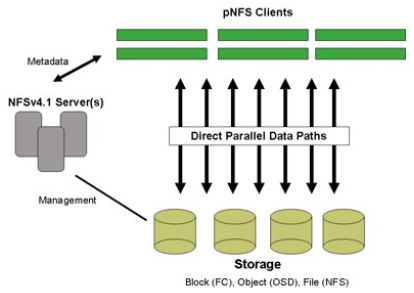- NFS:
- Primary file system for clusters, and is pretty much” plug and play” on most *nix systems.
- It was the first popular file system that allowed distributed systems to share data.
- NFSv3:
- The most popular version of NFS. It was released around 1995 and
- added several features including support for 64-bit file sizes and offsets (so it can handle files larger than 4GB), asynchronous write support, and TCP as a transport layer.
- NFSv4:
- Around 2003, NFSv4 was released with some improvements. In particular,
- it added some speed improvements, strong security (with compatibility for multiple security protocols), and NFS became a stateful protocol.
- NFS 的效能面:
- The good news for NFS and NAS is that many codes don’t require lots of I/O for good performance. These codes will run very well using NFS as the storage protocol even for large runs (100+ nodes or several hundred cores). NFS provides adequate performance until the input and output files for these codes become extremely large, or if the code is run across a very large number of processors (in the thousands).
- NFS still lacks the performance and scalability required by many large clusters, but that is about to change.
- pNFS (NFSv4.1):
- adding PFS capability to the NFS protocol. The goal is to improve performance and scalability while making the changes within a standard (recall that NFS is the only true shared file system standard).
- this standard is designed to be used with file based, block based, and object based storage devices with an eye towards freeing customers from vendor lock-in.
- pNFS Architecture,

- pNFS Sever 連接 Client 和 Storage ,當 Client 要存取檔案時先至 pNFS Server 查詢 Metadata 找到檔案的位置,再連接到存放檔案的 Sotrage
Last modified 17 years ago
Last modified on Mar 6, 2009, 11:19:32 AM
Attachments (1)
- pNFS_arch.png (59.1 KB) - added by rock 17 years ago.
Download all attachments as: .zip
